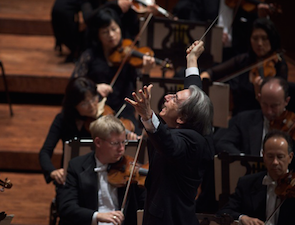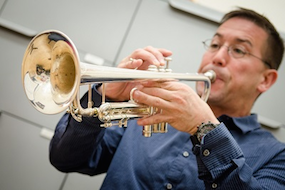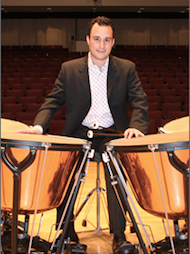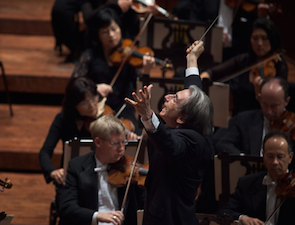
How lucky we were, an audience of some 1,900, Thursday night in Davies Symphony Hall!
Lucky to hear a superb performance of Mahler's least often played Symphony No. 7 that Michael Tilson Thomas and the San Francisco Symphony are taking on their November tour of the country.
And how lucky not to suffer through the dilemma that a significantly smaller audience faced the night before, focusing on the complex, magnificent music while wondering what's happening at the end of another 7 — Game 7 of the 2014 World Series, won by the San Francisco Giants just a few minutes after the first movement of the Mahler began. (Luck can be made — almost 500 ticket-holders cancelled or didn't show Wednesday, leaving the 2,740-seat hall exactly half full ... or half empty.)
The conflict extended all the way to the stage where passionate Giant fans such as principal trumpet Mark Inouye were performing music that challenges the greatest of brass players, knowing that it was the ninth inning, but not who won.
On Thursday, there was only sharing in the city's joy and no more distraction — perfect for a work which traverses 80 minutes from "night music" to triumph. "The Seventh," wrote the late Michael Steinberg, "is a victory symphony, not a personal narrative but a journey from night to day."

The huge opening Allegro was all of one piece, with Michael Tilson Thomas conducting a perfectly balanced performance by the 100+ orchestra overflowing the stage, with rock-solid tempos, and the music speaking so powerfully and eloquently as in any performance or recording I've ever heard.
The violins, seated downstage on either side of the conductor, instead of hiding the second violins, led masterfully by section principal Dan Carlson. The strings laid down a golden carpet for the massive brass section chorales, and Inouye was equally brilliant in the highest, loudest passages as in the quiet, haunting refrains.
Bob Ward's horn, Jeff Anderson's tuba, and Timothy Higgins' mighty trombone realized all the instruments' solo roles in this movement and in the Rondo-Finale; in a different, but equally spectacular manner when it came to Nachtmusik I.
When you are close to an orchestra, almost on a daily basis, there is not enough distance to notice changes and progress the same way that's the case with an orchestra visiting occasionally, but hearing the Seventh locally for the first time since 2007 provides a a clear indication of World Series-class development: This is a brass section that's the equal of Chicago, New York, and even Berlin.

The controlled orgy of sound at the climax of that big opening Allegro risoluto ma non troppo virtually demanded an improper mid-symphony ovation, and yet the exemplary audience just sat in awed silence. During the entire performance, there was only one audience "outburst" by a few people, at the end of the quiet, hushed Nachtmusic II, the very opposite of a barn-burner fortissimo movement, such as the opening and closing ones, but I understand why the magical sound MTT/SFS produced there prompted the unusual response.
This truly is the heart of the work, some of the composer's most passionate but understated music ("quietly passionate"?), reminiscent of both Wagner and Richard Strauss, but uniquely Mahler's. Once again, the orchestra was a wonder to behold, featuring concertmaster Alexander Barantschik's violin solos, Howard Kadis' tremolo mandolin, woodwinds and strings in flawless sync. Woodwind solos featured principal players Tim Day (flute), Jeff Rathbun (oboe), Carey Bell (clarinet), and Steve Paulson (bassoon).
Between the two "night music" movements, the quirky, ghostly Scherzo was another triumph, the orchestra responding to Jonathan Vinocour's viola to live up to Steinberg's description of "... notes scurry about, cobwebs brush the face, witches step out in a ghostly parody of a waltz."
During the standing ovation at the end of the work, an audience member told me what I was thinking myself: "I wish they repeated the first movement instead of the Finale." However exceptional the unrestrained, pulsing performance was — timpanist Alex Orfaly and percussionist Jacob Nissly raising the roof in cahoots with the brass — I never could and I still cannot accept the closing movement as anything but anticlimactic compared with the rest of the work.
Your mileage may differ, but regardless, I highly recommend this performance either in Davies on Saturday, on the road during the orchestra tour, or on KDFC-FM. The station will broadcast recording of a 2005 performance on Nov. 11, and then the current performance on Feb. 24, 2015.

